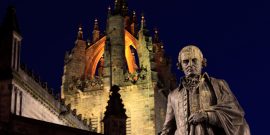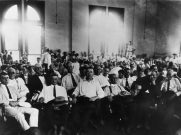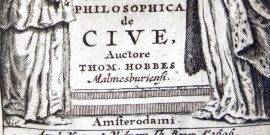The public's authentic position about any number of issues may be corrupt—Adam Smith may guide us through the alternative.
Cosmos-ology
The television program Cosmos: A Spacetime Odyssey is worth watching for reasons known and acknowledged by host Neil deGrasse Tyson, and for some he may not be aware of. Tyson exudes an affable authority as he guides viewers through this expensively produced and visually impressive successor to the 1980s blockbuster science documentary Cosmos: A Personal Voyage, hosted by Carl Sagan. While the series presented by Fox and National Geographic is not yet finished (11 of 13 episodes have been aired), its essential features are discernable.
In many ways, it is a fascinating and informative look at scientific endeavors to unlock the secrets of the cosmos, including life here on earth. Tyson, a Harvard-and Columbia-trained astrophysicist, is especially good on vast, non-living phenomena: the Big Bang, galaxies and worlds, stars and light, as well as the staggering dimensions of space (“a network of a hundred billion galaxies,” ever-expanding) and time (13.8 billion years and counting) in which cosmic history plays itself out.
Tyson isn’t one to shy from the often-strange concepts that astrophysics and cosmology find it necessary to employ (dark matter, black holes, light years), which challenge earth-centered, ordinary experience and categories. What he does avoid, at least for the most part, is addressing the dichotomy between here and Out There. If he does touch upon it (for example, in episode four, “A Sky Full of Ghosts”), the cosmic perspective tends to win out over earthbound views. At dawn, the sun seems to us to appear on the horizon, but in actual fact it doesn’t until two minutes later—cut to informative graphic on the earth’s atmosphere deflecting the sun’s rays and creating this image or illusion.
This revision of our ordinary experience cannot be fully sustained. As a result, the show veers schizophrenically back and forth between the inhuman scale and optics of cosmology, with its objects dwarfing and indifferent to us, and the human scale of historical time and concerns about, for example, fossil fuels.
Implicit in this is a real puzzle: What is this distinctive form of life, human life, that is open to the pursuit of self-transcending and even self-forgetting knowledge and seeks a habitable home? It’s not a new mystery, of course. A Socrates or a Pascal would help pose illuminating questions about this remarkable being and his vital principle, the human psuché or soul.
Tyson is no Socrates; mysteries of this sort remain unexamined. Not that he isn’t vaguely aware of them, though, and to compensate for the cosmic vastness and conceptual strangeness, and also for reasons of boosterism (to extol the life of scientific inquiry, a laudable goal in itself), he seeks to humanize the scientific enterprise. He recounts not just the experiments and theorizing of scientific discoveries, but the persons, passions, and lives engaged in them.
For example, he does scientific justice (and flatters contemporary liberal pieties) when he extols Arabs’ and women’s outstanding contributions to astronomy. All that is to the good, of course. Yet it still begs the Pascalian question: Is the nature of “the thinking reed” really accounted for by the cosmic nature of infinities and infinitesimals that modern science employs in its explanations?
Tyson’s answer is in the affirmative, though it is assumed rather than argued for. If one were to tease out the assumptions of the presenter of Cosmos—scientific man, astrophysics subspecies, materialisticus debonairius—one would get the following: It is rather anti-Christian (although in a passive-aggressive way); dogmatically materialistic; and inclined to blithely promote an alternative religiosity or “spirituality” that sees all forms of life as brothers under the skin, composed of the same “star stuff,” permutations of the same basic code. Instead of, say, the Cross or the Star of David, his spirit resonates before the awesome Tree of Life.
Life inspires his reverence. Even as he professes not to know where it comes from, he insistently points to the cosmos for its provenance. We human beings need to recognize that it is the cosmos, not the Biblical creator God, which is the origin of our matter and our form as human beings. Forget the soul, immortal or not; forget creative reason. Only material causes obtain. Moreover, our knowledge of them requires us to foresee the end of the sun, the earth, and the life it harbors. If that sounds disheartening, don’t worry—it’s all quite marvelous nonetheless. Sit down and have a glass of fine wine as you watch the story of the Cosmos unfolded by Science. (Tyson is a wine enthusiast and ends the segment on women scientists, “Sisters of the Sun,” in this oenophile vein.)
In this optic, l’infâme is Christianity. In the first episode, “Standing Up in the Milky Way,” devoted to situating the earth within the space-time continuum of modern cosmology, there is a gratuitous telling of the story of Giordano Bruno and his death at the hands of the Inquisition. According to Tyson, the martyrdom was for “freedom of thought” and for positing “the infinity of the universe.” Copernicus is briefly mentioned but not chosen for representation, probably because his orthodox Catholic faith (and being patronized by a Pope and prelates) does not support a critique of Christianity. (Something similar would be true of the Lutheran Kepler and, for that matter, the Augustinian friar Gregor Mendel, founder of the modern science of genetics.)
That Bruno was not considered a scientist by the Church—his heresies were theological—comes only as an aside at the end of the episode. The reason for his belief in the infinity of the universe—the Creator is infinite, so an infinite universe would be worthier of His majesty—wouldn’t pass scientific muster. Still, if Bruno can be turned into a Galileo-style example, he’s useful to Tyson to further the black legend of Church versus Science.
In a later episode, our host takes sober delight in demolishing the pitiable “young earth” creationist dating of the planet on which we live. This, one can infer, is all you need to know about people who affirm the truth of the Bible concerning creation and man. Ken Ham and Bill Nye, however, do not exhaust the intellectual possibilities relative to Christian faith and reason and the nature of the universe and man. Tyson apparently has never heard of form-criticism in connection with Genesis 1, or the Vatican Observatory (which dates to the 18th century, with earlier antecedents).
There’s more, but the main point is clear: While there are a few countervailing facts to be found in Cosmos, it is not a sincere effort to deal with the complicated story of faith and reason. Its parti pris in this area is actually quite unscientific.
The same is true of its Darwinian fundamentalism (to use Stephen Jay Gould’s phrase) in explaining the appearance of human life on earth. In general, Tyson is captive to the genetic fallacy: the belief that understanding the origins and development of a phenomenon or being is tantamount to understanding it tout court. That’s called a fallacy for a reason. It is systematically reductionist of Tyson to do what he does—to constantly look at where we came from rather than at what (and who) we are.
Among the many scientifically credentialed thinkers who have pointed out the limitations of orthodox evolutionary thinking, and countered the reductionism inherent in it, is the biological psychologist and phenomenologist Erwin Straus (1891-1975). In his classic essay, “The Upright Posture,” he wrote:
Paleontology tells what man or what his ancestors once were but not what man actually is. . . . Looking from man to the hominids or the other primates, we see what man no longer is. Looking from the other primates to man, we see what the other primates are not yet. Any explanation of the causes of evolution demands a knowledge of both the old and new forms [emphasis added].[1]
Tyson’s evolutionary approach forecloses this direct consideration and understanding. Straus maintained that:
with all due respect for the accomplishments of those early ancestors, we should not forget to investigate our own situation. Man is not only the end of a long development; he also represents a new beginning. One may doubt if old rocks will reveal all the secrets of human existence.
Insofar as Tyson countenances a direct scientific consideration of man, his materialistic presuppositions continue to hamper him. His appeal to neurobiology, for example, founders on methodological grounds as a petitio principii, as well as on substantive grounds because its blinkered view leaves out the reality of psuché, of soul or organic form, in the constitution of man (and in all forms of life). Here, of course, we enter into contested terrain.
To illustrate the explanatory power of evolutionary theory, Tyson turns to the organ of sight, the eye. He knows this is a controversy between orthodox evolutionary theorists and their various critics, including, but not limited to, proponents of Intelligent Design. The latter make the case that the nature of sight—the delicate balance of the eye’s material elements and immaterial powers, its marvelous distance-transcending but distance-maintaining achievements[2] –can more plausibly be understood within some hylomorphic and teleological framework than the matter, chance, and natural selection schema of orthodox Darwinism.
Our host takes up the challenge, offering at some length an evolutionary account of sight and the eye’s emergence. To speak rather bluntly: the account provided by him is embarrassing in its hocus-pocus, magic wand character. It requires acts of faith, as it were, at every turn. To be sure, the intellectual and explanatory debility we find in Cosmos does not of itself justify creation or even Intelligent Design as metaphysical propositions. But the presentation does next to nothing to assist viewers seeking to understand the merits and demerits of the competing positions in the debate.
A different treatment of the eye and sight is developed by Leon Kass. A chapter of his book The Hungry Soul entitled “The Primacy of Form” argues for the reality and nature of organic form or soul. Kass writes:
One can point to or hold the eyeball, but one cannot point to or hold its power (sight) or its activity (seeing). These aspects of its form are themselves intangible because they are immaterial.[3]
The last word above summarizes the problem with Cosmos: its systematic blindness to immaterial dimensions of reality, whether cosmic, organic, or human. Kass, and Hans Jonas before him, have made a powerful case for the reality of organic form or soul in understanding all forms of life. Kass, by attending to the fundamental vital activity, metabolism, fills out Jonas’ point about organic being’s independence from its present material components. These two thinkers demonstrate that “organic” means “material and immaterial” in the composition of being.
At the cosmic level, Tyson himself regularly refers to the “logic” or “logical coherence” of the cosmos, as well as its mathematical principles and structures, without noting that these are immaterial realities. They are not the materials they structure and help render intelligible. What he calls the “laws of nature” sought by his science are not themselves material, nor is our knowledge of them.
Yes, the point is that obvious. But if you’re stuck in your methodological materialism, you’re not going to get it. Erwin Straus saw that it is the scientific enterprise itself that proves the inadequacy of materialism:
There is a striking ontological difference between things known and the human knowledge of things. The physicist who determines the velocity of light as a ratio of distance to time, comprehends spatial and temporal distances; he brings beginning and end of the travel together. A measurement of speed is not a descriptive copy of natural events. It reaches beyond the concrete situation. Although living in time with every breath and heartbeat, man is able to conceive time as time and ascribe numerical values to it. Science surpasses nature. It opens for man the door of his capsule, and he, without leaving his homestead, reaches out through the open door, far beyond himself, into space and time—traveling on the wings of words, meaning, and mathematics.
Would that the very intelligent Neil deGrasse Tyson gazed out the door of his capsule—that is, wondered about himself as a scientist and human being—in this spirit. If he did, his television odyssey would really take us somewhere.
[1] Erwin Straus, Phenomenological Psychology (Basic Books, 1966).
[2] See Hans Jonas, “The Nobility of Sight,” in The Phenomenon of Life: Toward a Philosophical Biology (University of Chicago Press, 1966).
[3] Leon Kass, The Hungry Soul: Eating and the Perfection of our Nature (The Free Press, 1994), p. 43.



